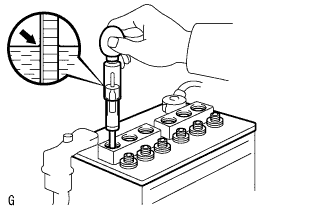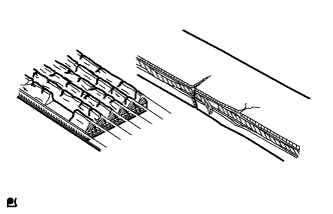Charging System (W/ Entry And Start System) -- On-Vehicle Inspection |
| 1. CHECK BATTERY CONDITION |
- NOTICE:
- If the battery is weak or if the engine is difficult to start, perform the following procedures.
Check the battery for damage or deformation. If severe damage, deformation or leakage is found, replace the battery.
Check the electrolyte quantity of each cell.
- HINT:
- Before checking the battery voltage, turn off all the electrical systems (headlights, blower motor, rear defogger, etc.).
For maintenance-free batteries:
- If the electrolyte quantity is below the lower line, replace the battery.
- If the electrolyte quantity is above the lower line, check the battery voltage when cranking the engine. If the voltage is below 9.6 V, recharge or replace the battery.
- If the electrolyte quantity is below the lower line, replace the battery.
For non-maintenance-free batteries:
- If the electrolyte quantity is below the lower line, add distilled water to each cell. Then, recharge the battery and check the electrolyte's specific gravity.
- Standard specific gravity:
- 1.25 to 1.29 at 20°C (68°F)
- If the electrolyte quantity is below the lower line, add distilled water to each cell. Then, recharge the battery and check the electrolyte's specific gravity.

Check the battery voltage.
Turn the engine switch off and turn on the headlights for 20 to 30 seconds. This will remove the surface charge from the battery.
Measure the battery voltage between the negative (-) and positive (+) terminals of the battery.
- Standard voltage:
- 12.5 to 12.9 V at 20°C (68°F)

| 2. INSPECT BATTERY TERMINAL AND FUSE |
Check that the battery terminals are not loose or corroded.
If the terminals are corroded, clean the terminals.
Measure the resistance of the H-fuses and fuses.
- Standard resistance:
- Below 1 Ω
- If the results is not as specified, replace the fuses as necessary.
| 3. INSPECT V-RIBBED BELT |
Check the belt for wear, cracks or other signs of damage.
If any of the following defects is found, replace the V-ribbed belt.- The belt is cracked.
- The belt is worn out to the extent that the cords are exposed.
- The belt has chunks missing from the ribs.
- The belt is cracked.
 |
Check that the belt fits properly in the ribbed grooves.
- HINT:
- Check with your hand to confirm that the belt has not slipped out of the grooves on the bottom to the pulley. If it has slipped out, replace the V-ribbed belt. Install a new V-ribbed belt correctly.
 |
Check the V-ribbed belt deflection and tension.
- Standard Deflection:
Item Specified Condition New belt 7.0 to 8.2 mm (0.276 to 0.323 in.) Used belt 7.6 to 10.0 mm (0.299 to 0.394 in.)
- Standard Tension:
Item Specified Condition New belt 700 to 800 N (70 to 80 kgf, 157.4 to 179.8 lbf) Used belt 550 to 750 N (55 to 75 kgf, 123.6 to 168.6 lbf)
- HINT:
- When inspecting the V-ribbed belt deflection, apply 98 N (10 kgf, 22.0 lbf) of tensile force to it.
- Check the V-ribbed belt deflection at the specified point.
- V-ribbed belt tension and deflection should be checked after 2 revolutions of engine cranking.
- Measure the belt tension when the engine is cold.
- When adjusting the belt, be sure to adjust it so that the tension is as close as possible to the median of the specified range.
- When replacing the belt with a new one, be sure to perform the following after adjusting the belt: idle the engine for 5 minutes, and then adjust the belt to the specified value for a new belt after the engine has cooled.
- When inspecting a belt which has been used for over 5 minutes, apply the used belt specifications.
- When using a belt tension gauge, confirm its accuracy by using a master gauge first.
 |
| 4. INSPECT GENERATOR WIRING |
Check that the wiring is in good condition.
If the wiring is damaged, repair or replace the generator wire.
| 5. CHECK FOR ABNORMAL NOISES |
Check that no abnormal noises are heard from the generator while the engine is running.
If there is abnormal noise, replace the pulley or generator.
| 6. INSPECT CHARGE WARNING LIGHT CIRCUIT |
Turn the engine switch on (IG). Check that the charge warning light comes on.
Start the engine and check that the light goes off.
If the light does not operate as specified, troubleshoot the charge warning light circuit.
| 7. INSPECT CHARGING CIRCUIT WITHOUT LOAD |
Connect the voltmeter and ammeter to the charging circuit as follows.
Disconnect the wire from terminal B of the generator, and then connect it to the negative (-) lead of the ammeter.
Connect the positive (+) lead of the ammeter to terminal B of the generator.
Connect the positive (+) lead of the voltmeter to the terminal B of the generator.
Ground the negative (-) lead of the voltmeter.
 |
Check the charging circuit.
Keep the engine speed at 2000 rpm and check the reading on the ammeter and voltmeter.
- Standard current:
- 10 A or less
- Standard voltage:
- 12.1 to 15.4 V
- HINT:
- If the battery is not fully charged, the ammeter reading will sometimes be higher than the standard current.
| 8. INSPECT CHARGING CIRCUIT WITH LOAD |
With the engine running at 2000 rpm, turn the high beam headlights on and turn the heater blower switch to the "HI" position.
Check the reading on the ammeter.
- Standard current:
- 30 A or higher
- HINT:
- If the battery is fully charged, the indication will sometimes be below the standard current. If this is the case, add more electrical load (operate the wipers, rear window defogger, etc.) and check the reading on the ammeter again.